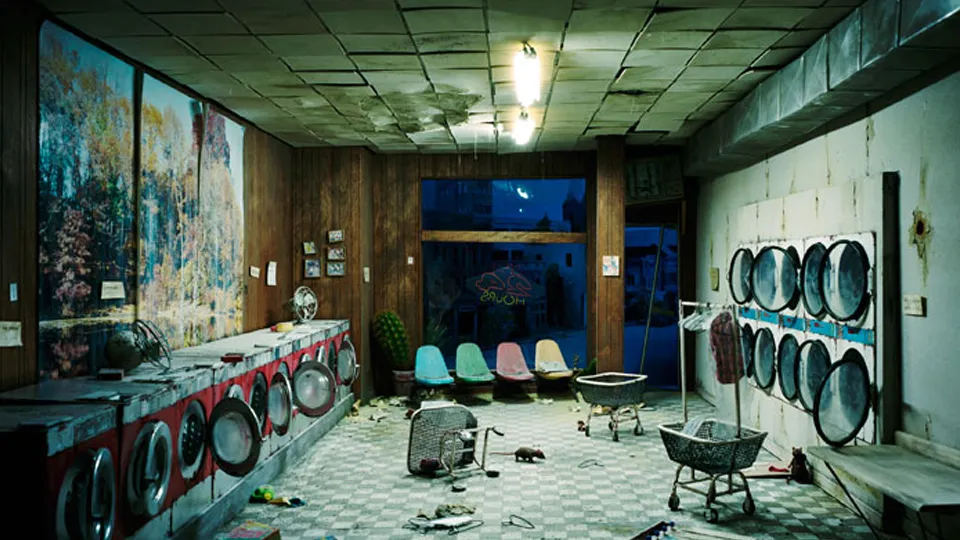Desolate landscapes hold a raw, haunting beauty that transforms ordinary photography into extraordinary art. These forgotten places whisper stories through cracked walls, rusted metal, and overgrown ruins.
🏚️ The Magnetic Allure of Decay in Modern Photography
There’s something undeniably captivating about photographing spaces where time has left its mark. Abandoned buildings, forgotten industrial sites, and weathered structures create visual narratives that polished, pristine locations simply cannot match. The texture of peeling paint, the geometry of broken windows, and the interplay of natural reclamation against human construction provide photographers with endless creative possibilities.
Professional photographers and Instagram enthusiasts alike are increasingly drawn to these ruined environments. The aesthetic appeal lies not in perfection, but in imperfection—the authentic, unfiltered passage of time captured in a single frame. These locations offer a stark contrast to the overly curated spaces that dominate social media feeds, providing refreshing visual content that stands out.
Urban exploration photography has evolved from a niche hobby into a recognized art form. Fashion brands, portrait photographers, and creative directors now actively seek out desolate backdrops to add depth, character, and emotional resonance to their work. The juxtaposition of human subjects against decaying architecture creates powerful visual metaphors about resilience, beauty in unexpected places, and the impermanence of our built environment.
Why Abandoned Spaces Create Photographic Magic ✨
Desolate landscapes function as natural studios with built-in atmosphere. The diffused light filtering through broken roofs, the organic color palettes of rust and weathered materials, and the unexpected textures create conditions that would cost thousands to replicate in a professional studio setting.
These environments offer several distinct advantages for photographers:
- Unique lighting conditions with dramatic shadows and natural spotlights
- Rich textures that add depth without additional props
- Authentic atmosphere that cannot be artificially recreated
- Minimal competition for shooting locations compared to popular scenic spots
- Built-in narrative elements that strengthen storytelling
- Versatile backdrops suitable for multiple photography genres
The emotional weight carried by abandoned spaces adds psychological depth to images. Viewers respond to the layers of history embedded in these locations, creating connections that extend beyond simple visual appeal. A portrait taken against graffiti-covered walls tells a different story than one shot in a sterile white studio.
🎨 Finding Your Perfect Ruined Location
Discovering exceptional desolate landscapes requires research, patience, and respect for property boundaries. Start by exploring your own region—many cities contain forgotten industrial areas, closed institutions, or neglected architectural gems hiding in plain sight.
Online communities dedicated to urban exploration can provide valuable leads, though locations are often kept confidential to prevent vandalism and overcrowding. Social media platforms, particularly Instagram and Pinterest, serve as visual databases where you can identify location styles that match your aesthetic vision.
Consider these location types for your next photoshoot:
- Abandoned factories and industrial complexes
- Forgotten railway stations and infrastructure
- Closed hospitals and institutional buildings
- Derelict churches and religious structures
- Weather-beaten coastal installations
- Overgrown gardens and estate ruins
- Shuttered amusement parks and entertainment venues
- Deserted shopping centers and commercial spaces
Always prioritize legal access. Many property owners grant permission for photography, especially when approached professionally with clear intentions and liability coverage. Trespassing risks legal consequences and contributes to the deterioration of these valuable cultural artifacts.
Technical Considerations for Shooting in Challenging Environments 📷
Photographing in desolate locations presents unique technical challenges that require preparation and adaptability. Lighting conditions fluctuate dramatically within abandoned structures, demanding equipment versatility and technical knowledge.
Natural light becomes your primary tool in these environments. Early morning and late afternoon provide the golden hour glow that enhances textures and creates dimensional shadows. Overcast days produce beautifully diffused light that eliminates harsh contrasts, perfect for portrait work against textured backgrounds.
Essential gear considerations include:
- Wide-angle lenses to capture architectural context
- Fast prime lenses for low-light conditions
- Sturdy tripods for stability on uneven surfaces
- External flash or continuous LED lights for fill lighting
- Lens hoods to manage unpredictable light sources
- Protective filters to shield against dust and debris
Camera settings require flexibility. Start with aperture priority mode to control depth of field while adapting to changing light. Increase ISO as needed—modern cameras handle noise remarkably well, and slight grain can actually enhance the aesthetic of ruined environment photography.
Composition becomes crucial when working with visually complex backgrounds. The rule of thirds helps balance your subject against busy architectural elements. Look for leading lines in deteriorating structures—staircases, corridors, and broken beams guide viewers’ eyes through the frame naturally.
🌿 Nature’s Reclamation as Visual Poetry
The most compelling desolate landscapes feature nature slowly reclaiming human construction. Vines creeping through windows, trees growing through floor cracks, and moss covering concrete create powerful visual metaphors about impermanence and resilience.
This natural reclamation adds color variation to otherwise monochromatic ruins. The vibrant greens of plant life contrast beautifully with grays, browns, and rusted oranges of decaying structures. Seasonal changes offer different photographic opportunities—spring blooms soften harsh architectural lines, autumn leaves add warmth, winter snow creates ethereal minimalism, and summer growth provides lush abundance.
Water features, whether intentional or from structural deterioration, add reflective surfaces that double visual interest. Puddles become natural mirrors, rain creates atmospheric conditions, and humidity adds mystical fog effects that enhance mood dramatically.
Styling Your Subject Against Desolation 👗
Fashion and portrait photography in ruined environments requires thoughtful styling to create harmony or intentional contrast between subject and setting. The weathered backdrop provides such strong visual character that styling choices significantly impact the final image’s narrative.
Contemporary fashion often pairs sleek, modern clothing against rough, deteriorated backgrounds. This juxtaposition creates visual tension that draws viewer attention. A flowing evening gown against crumbling brick walls tells a story about elegance persisting despite circumstances. Street style photography gains authenticity when shot in genuinely urban, worn environments rather than artificially distressed studio sets.
Color coordination matters significantly. Earth tones complement rust and weathered wood naturally, creating cohesive images. Alternatively, bold colors—vibrant reds, electric blues, or striking yellows—pop dramatically against muted backgrounds, making subjects command attention immediately.
Consider these styling approaches:
- Vintage clothing echoing the location’s historical period
- High fashion creating deliberate anachronistic contrast
- Natural, minimal styling letting the location dominate
- Dramatic makeup and styling emphasizing artistic intention
- Props that complement rather than compete with environment
Safety First: Navigating Hazardous Beauties ⚠️
The romantic appeal of ruined landscapes must never overshadow practical safety considerations. These environments contain genuine hazards that require respect, preparation, and common sense.
Structural instability poses the most significant risk. Floors may be compromised, ceilings unstable, and walls potentially collapsing. Never enter buildings showing obvious structural failure. Travel with partners who can assist in emergencies, and always inform someone of your location and expected return time.
Wear appropriate protective gear including closed-toe boots with ankle support, long pants to protect against sharp edges, and gloves when touching surfaces. Abandoned buildings may contain asbestos, lead paint, mold, or other environmental hazards. Research locations beforehand to understand specific risks.
Wildlife inhabits many abandoned structures. Respect these residents by maintaining distance and avoiding nesting areas. Some urban wildlife, including certain birds and rodents, can carry diseases or become aggressive when threatened.
Carry essential safety items:
- First aid kit with bandages and antiseptic
- Flashlights or headlamps with extra batteries
- Fully charged mobile phone with emergency contacts
- Water and basic snacks
- Dust masks for moldy environments
📱 Planning and Scouting with Technology
Modern technology transforms location scouting from guesswork into strategic planning. Satellite imagery through mapping applications allows preliminary assessment of locations before visiting. Street view features help evaluate accessibility and exterior conditions.
Weather forecasting becomes essential for planning shoots in exposed or partially roofed locations. Photography-specific weather apps provide detailed information about golden hour timing, cloud cover, and precipitation that directly impacts image quality.
Photography planning applications help visualize how light will interact with locations at different times. Some apps calculate sun positions throughout the day, allowing precise scheduling for optimal lighting conditions without wasting time on-site.
Social media serves double duty as inspiration source and scouting tool. Geotagged images reveal how others have photographed specific locations, showing various angles, seasonal variations, and creative approaches. This research prevents redundancy while inspiring unique interpretations.
🎭 The Ethical Dimension of Ruin Photography
Photographing abandoned spaces carries ethical responsibilities that conscientious photographers must acknowledge. These locations represent cultural heritage, community history, and sometimes personal memories for local residents.
The “leave no trace” principle applies absolutely. Remove nothing, add nothing permanent, and disturb nothing unnecessarily. Vandalism and theft accelerate deterioration, denying future photographers and preservationists access to these unique spaces. Graffiti “art” rarely enhances locations—it usually detracts from authentic decay aesthetics.
Respect extends to how images are shared publicly. Some photographers deliberately obscure location details to prevent overtourism that damages sites. Consider the consequences of publicizing vulnerable locations, particularly those containing valuable architectural elements or historical artifacts.
Community sensitivity matters significantly. Some abandoned buildings represent traumatic history or recent economic hardship for local populations. Glamorizing poverty or treating someone’s painful past as aesthetic backdrop demonstrates profound insensitivity. Research location history and approach subjects with appropriate gravity when necessary.
Transforming Raw Captures into Stunning Final Images 🖥️
Post-processing elevates good photographs of desolate landscapes into extraordinary images. The editing approach should enhance rather than overwhelm the authentic character that makes these locations compelling.
Start with basic adjustments—exposure correction, white balance refinement, and contrast enhancement. Ruined environments often benefit from slightly increased contrast to emphasize textures. Shadows can be lifted moderately to reveal detail while maintaining mood.
Color grading dramatically influences emotional impact. Warm tones create nostalgic, melancholic atmospheres perfect for storytelling. Cool tones emphasize isolation and abandonment. Desaturated palettes highlight textures and forms, creating timeless images that focus on shape rather than color.
Selective editing draws attention to subjects while maintaining environmental context. Vignetting subtly focuses viewer attention, while selective sharpening emphasizes key details—your subject’s eyes, interesting textures, or important architectural elements.
Avoid over-processing that creates obviously artificial results. The authenticity of ruined environments constitutes their primary appeal. Heavy-handed editing that introduces unrealistic colors or excessive clarity destroys this genuine quality, reducing images to cliché.
💡 Creative Approaches Beyond Standard Portraiture
Desolate landscapes offer opportunities for experimental photography that transcends conventional portrait work. Long exposure techniques create ghostly effects with moving subjects, suggesting the passage of time within timeless spaces. Multiple exposure blending layers different moments or locations into surreal composites.
Environmental storytelling uses these locations as narrative stages rather than simple backdrops. Create photo series that explore relationships between subjects and spaces, documenting how individuals interact with abandoned environments. This approach produces portfolio pieces with deeper conceptual foundations than isolated beautiful images.
Macro photography reveals unexpected beauty in deterioration details—rust patterns, paint peeling in intricate designs, nature’s small-scale reclamation. These detail shots complement wider environmental images, creating comprehensive visual stories.
Black and white photography strips away color distractions, emphasizing form, texture, and contrast. Many ruined environments reveal their strongest compositions when reduced to monochrome, where tonal relationships create drama without chromatic competition.
Building Your Portfolio with Distinctive Location Work 🌟
Photographers who master desolate landscape photography develop distinctive portfolios that separate them from competitors working in conventional settings. These images demonstrate creative vision, technical adaptability, and artistic courage—qualities clients value highly.
Consistency matters when building recognition around this aesthetic. Develop a signature approach to processing, composition, or subject styling that makes your work immediately identifiable. Whether you prefer high-contrast monochrome drama, muted color nostalgia, or vibrant fashion-forward contrast, consistency builds brand recognition.
Document your process through behind-the-scenes content. Showing how you navigate challenging locations, work with difficult lighting, and develop creative concepts adds value beyond finished images. This content engages audiences and demonstrates professionalism to potential clients.
Collaborate with models, stylists, and other creatives who appreciate this aesthetic. Building a team that understands the vision for desolate environment photography produces stronger results than working with collaborators who question the location choices or feel uncomfortable in non-traditional settings.
Where Ruin Meets Renaissance in Modern Visual Culture 🏛️
The popularity of desolate landscape photography reflects broader cultural fascinations with authenticity, history, and imperfection. In an increasingly digital, curated world, these unpolished spaces offer visual relief—honest expressions of time’s effects without Instagram filters or artificial enhancement.
This aesthetic connects to larger movements in art, fashion, and design celebrating wabi-sabi—the Japanese concept finding beauty in imperfection and impermanence. Ruined environments embody this philosophy perfectly, presenting decay not as failure but as natural transformation deserving appreciation.
Commercial applications continue expanding as brands recognize the emotional resonance these environments create. Advertising campaigns increasingly feature authentic urban decay rather than constructed sets, lending credibility and edge to products. Music videos, fashion editorials, and artistic projects routinely incorporate abandoned locations for their unmatched atmospheric qualities.
As this photographic genre matures, opportunities grow for photographers who approach these subjects with respect, creativity, and technical excellence. The key lies in seeing beyond surface-level “cool” aesthetics to understand and communicate the deeper stories these spaces tell—narratives about change, memory, resilience, and beauty found in unexpected places.
Desolate landscapes will continue captivating photographers and audiences because they satisfy fundamental human fascinations with time, mortality, and transformation. Every crumbling wall and overgrown room represents a meditation on impermanence, making these forgotten places paradoxically timeless subjects for stunning photographic art.
Toni Santos is a visual explorer and microscopic storyteller who delves into the hidden aesthetics of microbial life. Through a fusion of scientific curiosity and artistic insight, Toni transforms the overlooked world of bacteria, fungi, and cellular forms into mesmerizing visual narratives—revealing the elegance, symmetry, and chaos that thrive at microscopic scales.
Rooted in a fascination with life forms too small to see yet too intricate to ignore, Toni’s work captures the bizarre beauty of microbial colonies, biofilms, and spore patterns. These images aren’t just representations—they are celebrations of the artistic intelligence encoded in nature’s tiniest architects.
With a background in visual design and bio-inspiration, Toni merges scientific imaging techniques with creative expression, transforming petri dish cultures, fluorescence microscopy, and microbial textures into works that provoke both wonder and contemplation.
As the creative force behind Vizovex, Toni offers curated visual studies, microbial-inspired designs, and essays that bridge art and microbiology—inviting viewers to reimagine what beauty means at the edge of perception.
His work is a tribute to:
The hidden geometries of living systems
The surprising elegance of microbial growth
The role of micro-life in shaping visual culture
Whether you’re a scientist, artist, or simply curious about the unseen world that sustains us, Toni opens a window into a universe where life writes poetry in colonies and patterns, one microbe, one frame, one breathtaking detail at a time.





